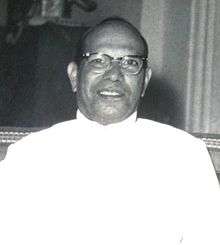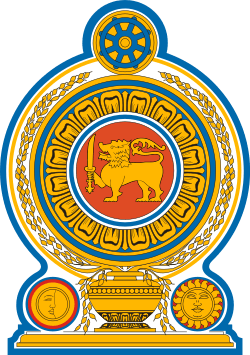William Gopallawa
| His Excellency William Gopallawa විලියම් ගොපල්ලව விலியம் கோபள்ளவா MBE | |
|---|---|
 | |
| 1st President of Sri Lanka | |
|
In office 22 May 1972 – 4 February 1978 | |
| Prime Minister |
Junius Richard Jayewardene Sirimavo Bandaranaike |
| Preceded by | Inaugural holder |
| Succeeded by | Junius Richard Jayewardene |
| Governor-General of Ceylon | |
|
In office 2 March 1962 – 22 May 1972 | |
| Monarch | Elizabeth II |
| Preceded by | Oliver Ernest Goonetilleke |
| Succeeded by | Office abolished |
| Secretary General of Non-Aligned Movement | |
|
In office 16 August 1976 – 4 February 1978 | |
| Preceded by | Houari Boumédienne |
| Succeeded by | Junius Richard Jayawardene |
| Personal details | |
| Born |
17 September 1896 Matale, British Ceylon (now in Sri Lanka) |
| Died |
31 January 1981 (aged 84) Colombo, Sri Lanka |
| Spouse(s) |
Seelawathie Gopallawa (née Rambukwella) |
| Children | 5 |
| Alma mater |
St. Anthony’s College Dharmaraja College |
| Religion | Theravada Buddhism |
William Gopallawa, MBE (Sinhala: විලියම් ගොපල්ලව, Tamil: வில்லியம் கோபள்ளவா) (17 September 1896 – 31 January 1981) was the last Governor-General of Ceylon from 1962 to 1972 and became the first (non-executive) President of Sri Lanka when Ceylon declared itself a republic in 1972 and changed its name to Sri Lanka. Until 1972, Ceylon was a Commonwealth realm with Queen Elizabeth II as the head of state and Queen of Ceylon. He was well known as an austere, nonpartisan and statesmanlike figure who commanded the respect of all political parties.
He represented an era where politics was conducted with a dignified aura and he had a reputation as being a man of integrity and humility. He served as Governor-General during the tenure of different governments headed by Sirimavo Bandaranaike of SLFP and Dudley Senanayake of UNP. He upheld the law and the constitution to the letter and won respect and admiration of all political parties.
Early life
William Gopallawa was born on 17 September 1896 at the Dullewe Maha Walauwa, Dullewe in the Matale District of Ceylon. He is related to Dullewe Dissava, a signatory on behalf of the Sinhalese to the Kandiyan Convention of 1815, by his mother Tikiri Kumarihamy Dullewe. His father, Tikiri Bandara Gopallawa died when he was three years old.[1]
He received his primary education at the Dullewe village school and at St. John's College, Kandy. He continued his secondary education at Dharmaraja College, Kandy where he was a Scout and later moved to St. Anthony's College, Kandy.[1] After having sat the Cambridge Senior Certificate Examination in 1917 he returned to his home town Matale and joined as the tutorial staff of Buddhist English School, Matale (now Vijaya College) and was also instrumental in setting up a library and a Scout troop for the benefit of the students there. In 1920 William joined the Ceylon Law College, Colombo and was enrolled as a Proctor and Notary Public in 1924. He was in active practice in Matale, Dumbara and Kandy from 1924 until he took up duties as Municipal Commissioner, Kandy in 1939.

Political life
In 1926 Gopallawa contested and won in the Matale Urban Council Elections and served continuously in the council for a period of 13 years from 1926 - 1939. He served as the chairman of the Matale Urban Council for 5 years, at his office he was the youngest Urban Council Chairman in Ceylon at that time. In 1936 Gopallawa unsuccessfully contested for the Matale seat at the State Council Elections in 1936. In 1939 the Kandy Municipal Council was established and Gopallawa was appointed as the first Municipal Commissioner of Kandy. He served in that capacity throughout World War II and acquitted himself for efficiency during the great floods in 1950. In 1951 he was appointment as Municipal Commissioner of Colombo Municipal Council and served until 1957 when he stepped down from the post.
Diplomatic role
On 18 June 1958 when S. W. R. D. Bandaranaike's government started diplomatic relations with People's Republic of China Gopallawa was posted as the second Ambassador to China in 1960. On 7 September 1961, while he was serving in China, he was recalled and posted as the Ambassador to the United States; he served there until 1962.
Governor-General of Ceylon & President of Sri Lanka
In 1962, he was called back to Ceylon, after his son in law's sister, the then prime minister Sirimavo Bandaranaike nominated Gopallawa as Governor-General of Ceylon following Sir Oliver Goonetilleke's implication in the attempted military coup earlier that year. He was the second Ceylonese Governor-General and the first Buddhist to hold the post as the representative of Queen Elizabeth II who was the Head of State. Gopallawa served in this capacity until 1972.
His constitutional decision to invite the UNP which won the majority of Parliamentary seats in the 1965 general election, (but not enough for an absolute majority) is heralded as a landmark moment where he respected the nation's constitution and its people's wishes more than the wishes of the defeated SLFP government (that appointed him as GG) which wanted him to delay inviting the winning party to form the government. It averted a major crisis of leadership.
When Ceylon became the Republic of Sri Lanka on 2 March 1972, Gopallawa became the first President. He stepped down from office in February 1978 when then Prime Minister Junius Richard Jayewardene became President following constitutional changes that effected the creation of an executive Presidency.
Faith
While he was a devout Buddhist, he respected all faiths and never failed to attend the annual Vel Hindu ceremony and never failed to host Christmas carols and also attended various Muslim ceremonies in his role as titual head of state; he was acutely cognizant of his role as a unifier of all Sri Lankans during his tenure. He was the first to establish a spartan Buddhist Shrine room at the Queen's House.
Family
Gopallawa married Seelawathie Rambukwella Gopallawa;they had 5 children. He was survived by 4 children out of 5. One died early on while he was still working in Matale. His eldest daughter Chandrika Iranganie married Dr. Mackie Ratwatte, the private secretary and a brother of Sirimavo Bandaranaike. His oldest son Asoka is a highly successful entrepreneur businessman,His Second daughter Chinthamani, was a teacher and landed proprietor and his youngest son Monty Gopallawa who died in 2005 was a very popular member of parliament and an affable cabinet minister in the government of President Chandrika Kumaratunga (daughter of Sirimavo Bandaranaike). He had 13 grandchildren; Chandhaka, Dhammika, Mano, Anushka, Devika, Avanthi, Sureka, Lehka, Shiranthani, Ashani, Mahen, Shanika and Dilani
Honours
- Member of The Most Excellent Order of the British Empire (MBE) [2]
- LLD (Honoris Causa) from the University of Ceylon in 1962
- LLD from the Vidyalankara in 1962
- D.Litt. from the Vidyodaya in 1962.
- King Birendra of Nepal Coronation Medal on 24 February 1975
See also
References
- 1 2 Basnayake, Richard (30 January 2009). "William Gopallawa". Daily News (Sri Lanka). Retrieved 17 April 2012.
- ↑ William Gopallawa, the first President
- A dignified symbol of the nation Daily News on the 104th birth anniversary
- William Gopallawa, the first President The 31st anniversary of Presidency
- New York times news on Death
- First President of the Republic of Sri Lanka
External links
- The Gopallawa Ancestry
- Gentleman par excellence
- A person of great virtue
- William Gopallawa's presidential Flag on crwflags.com
- Methek Kathawa Divaina
| Government offices | ||
|---|---|---|
| Preceded by — |
President of Sri Lanka 1972–1978 |
Succeeded by Junius Richard Jayewardene |
| Preceded by Sir Oliver Ernest Goonetilleke |
Governor-General of Ceylon 1962–1972 |
Succeeded by Abolished |
| Political offices | ||
| Preceded by Houari Boumédienne |
Secretary General of Non-Aligned Movement 1976–1978 |
Succeeded by Junius Richard Jayewardene |


